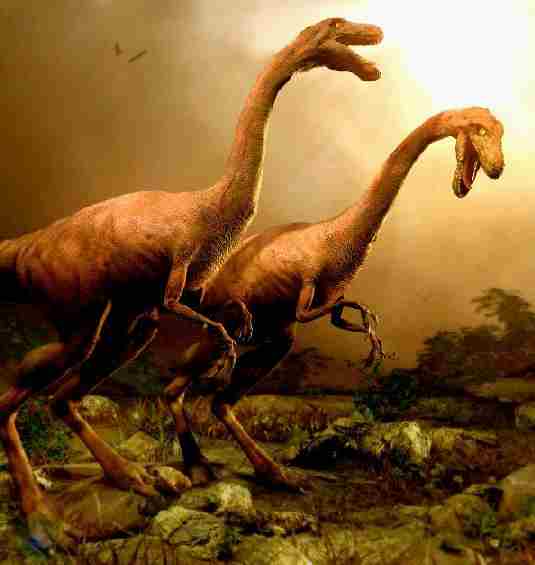
Dinosaurs are extremely varied; some herbivorous, others carnivorous; some bipedal, others quadrupedal. For details on the various types of dinosaurs, see 'Classification' below.
SIZE
Only a tiny percentage of animals are ever fossilized, and most of those are still buried in the earth. As a result, the smallest and largest non-avian dinosaurs will probably never be discovered. Even among those that are recovered, very few are known from complete skeletons and even impressions of soft tissue like skin is very rare. So reconstructing a skeleton by comparing the size and morphology of the bones to the bones of similar, better-known species is inexact; and restoring the muscles and other organs is at best educated guesswork.
While the largest and smallest will probably remain unknown, and comparisons between existing specimens is imprecise, it is clear that as a group they were very large. But even by dinosaur standards the sauropods were gigantic. The smallest sauropods were larger than anything else in their habitat, and the largest were an order of magnitude more massive than anything else that has ever walked the Earth.
The tallest and heaviest dinosaur known from a complete skeleton is still the Brachiosaurus (now Giraffatitan) which was discovered in Tanzania between 1907–1912, and is now mounted in the Humboldt Museum of Berlin. It is 12 m (38 ft) tall, and probably weighed between 30,000–60,000 kg (30–65 tons). The longest is the 27 m (89 ft) long Diplodocus which was discovered in Wyoming, and mounted in Pittsburgh's Carnegie Natural History Museum in 1907.
There are bigger dinosaurs, but they are known from only a small handful of bones. The current record holders all date from the 1970s or later, and include the massive Argentinosaurus, which may have weighed 80,000–100,000 kg (90–110 tons); the longest, the 40 m (130 ft) long Supersaurus; and the tallest, the 18 m (60 ft) Sauroposeidon, which could have reached into a 6th-floor window.
No other group of terrestrial animals even comes close. The largest elephant on record weighed a mere 12,000 kg (13.5 tons), and the tallest giraffe was just 6 m (20 ft) tall. Even giant prehistoric mammals like the Indricotherium and the Columbian mammoth were dwarfed by the giant sauropods. Only a small handful of aquatic animals approach it in size, of which the blue whale is largest, reaching up to 190,000 kg (210 tons) and 33.5 m (110 ft) in length.
Discounting modern birds like the bee hummingbird, the smallest dinosaurs known were about the size of a crow or a chicken. The Microraptor, Parvicursor, and Saltopus were all under 60 cm (2 ft) in length.
BEHAVIOUR
The behavior of dinosaurs will always be a mystery because none exist today. Paleontologists must rely on trace fossils for direct evidence of a dinosaur's behavior while alive. Interpretations based on the pose of a body fossil and its habitat, computer simulations of their biomechanics, and comparison with modern animals in similar ecological niches rely on speculation and promise to generate controversy for the foreseeable future. However, it is likely that at least the behaviors common in both of their closest living relatives, crocodiles and birds, are also common among dinosaurs.
The first evidence of herding behavior was the 1878 discovery of 31 Iguanodon that perished together in Bernissart, Belgium [4] (http://www.dinohunters.com/Iguanodon/bernissart_page.htm), and similar mass deaths and trackways suggest that herd or pack behavior is common among many dinosaur groups. Trackways of hundreds or even thousands of herbivores indicate that duck-bills (hadrosaurids) may have moved in great herds, like the American Bison or the African Springbok. Sauropod tracks document that they traveled in groups composed of several different species, at least in Oxford, England [5] (http://news.nationalgeographic.com/ and others kept their young in the middle of the herd for defense according to trackways at Davenport Ranch, Texas. Dinosaurs may have congregated in herds for defense, migration, or to care for their young.
Jack Horner's 1978 discovery of a Maiasaura ("good mother dinosaur") nesting ground in Montana demonstrated parental care long after birth among the ornithopods [6] (http://www.isgs.uiuc.edu/ [7] (http://www.browningmontana.com/dinosaurs.html), and similar nesting behavior and even huge nesting colonies like those of penguins have been discovered of other Cretaceous dinosaurs like the Patagonian sauropod Saltasaurus (in 1997).
The Mongolian maniraptoran Oviraptor was even discovered in a chicken-like brooding position in 1993, which may mean it was covered with an insulating layer of feathers that kept the eggs warm [8]. Trackways have also confirmed parental behavior among sauropods, and ornithopods from the Isle of Skye in the United Kingdom [9] (http://news.bbc.co.uk/1/hi/scotland/3255494.stm). Nests and eggs are known from most major groups of dinosaurs, and it appears likely that dinosaurs communicated with their young, like modern birds and crocodiles.
The crests and frills of some dinosaurs, like the marginocephalians, theropods and lambeosaurines, may have been too fragile for active defense so they were probably used for sexual or aggressive displays, though little is known about dinosaur mating and territorialism. Communication is also an enigma, but the hollow crests of the lambeosaurines may have been resonance chambers, used for a wide range of vocalizations.
For more information related to dinosaurs, visit rareresource.com.

0 comments:
Post a Comment